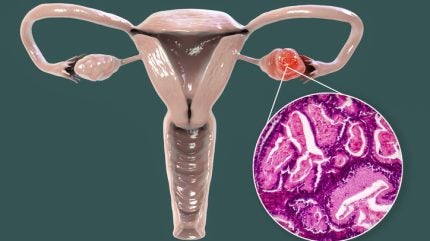
Platinum-based therapies remain the mainstay treatment for patients with endometrial (EC) and ovarian cancers (OC). However, both cancers are frequently marked by recurrence and the eventual development of resistance to platinum-based (Pt-based) regimens, underscoring a significant unmet need.
Antibody drug conjugates (ADCs) have emerged as a transformative treatment modality, particularly following the approval of ImmunoGen‘s Elahere (mirvetuximab soravtansine), a folate receptor alpha-directed ADC indicated for Pt-resistant OC after one to three prior systemic therapies.
Other promising ADC candidates targeting different pathways are in development for gynecologic cancers. At the European Society for Medical Oncology (ESMO) Congress, held on September 13-17, 2024, new data from the Phase II TROPION-PanTumor03 trial were presented. This trial evaluated Daiichi Sankyo and AstraZeneca’s datopotamab deruxtecan (Dato-DXd) as a monotherapy in patients with recurrent EC and OC who had progressed after one to two lines of Pt-based chemotherapy. The results demonstrated a trend toward improved outcomes and a manageable safety profile, although further investigation is warranted.
Dato-DXd is a trophoblast cell surface antigen 2 (TROP2)-directed monoclonal antibody linked to a deruxtecan-based topoisomerase I inhibitor via a highly selective, serum-stable, cleavable tetra-peptide linker, leveraging Daiichi Sankyo’s proprietary DXd technology. Overexpression of the TROP2 protein is associated with accelerated tumour growth and poor prognosis in several solid tumours, including breast, gastric, lung, and gynecological cancers.
At the time of data cutoff, the EC cohort, with a median of one prior line of therapy, demonstrated an overall response rate (ORR) of 27.5% and a disease control rate (DCR) of 85%. The median duration of response (DoR) was 16.4 months, and the median progression-free survival (PFS) was 6.3 months (95% CI: 2.8-not yet reached). In the OC cohort, with a median of two prior lines of therapy, the ORR was 42.9%, the DCR was 91.4%, the median DoR was 5.7 months, and the median PFS was 5.6 months (95% CI: 4.1–7.1). The trial included both Pt-sensitive and Pt-resistant OC patients. Pt-sensitive patients (n=9) had an ORR of 66.7%, DCR of 100%, median DoR of 8.5 months, and Pt-resistant patients (n=26) had a lower ORR of 34.6%, DCR of 80.8%, and median DoR of 5.6 months. Better outcomes for Pt-sensitive patients warrant additional investigation of the impact of Pt status on treatment outcomes with a larger cohort.
There appeared to be greater efficacy in the OC cohort compared to the EC cohort. Notably, neither cohort was selected for TROP2 expression, raising the question of whether TROP2 expression levels correlate with these outcomes. Retrospective analysis of TROP2 expression may provide further insight into whether assessing TROP2 levels is necessary in OC and the potential for personalised treatment. Safety data revealed that grade 3 or higher treatment-related adverse events (TRAEs) occurred in 42.5% of EC and 45.7% of OC patients. The most common TRAEs included any grade stomatitis, affecting 52.5% of the EC cohort and 62.9% of the OC cohort, and any grade nausea (37.5% in EC, 48.6% in OC), with most cases being grade 1 and 2. There were low rates of grade 3 adjudicated drug-related interstitial lung disease with one case per cohort. No grade 4 or 5 events or treatment-related deaths occurred, although two patients in the OC cohort and three patients in the EC cohort experienced discontinuation due to TRAEs.
How well do you really know your competitors?
Access the most comprehensive Company Profiles on the market, powered by GlobalData. Save hours of research. Gain competitive edge.

Thank you!
Your download email will arrive shortly
Not ready to buy yet? Download a free sample
We are confident about the unique quality of our Company Profiles. However, we want you to make the most beneficial decision for your business, so we offer a free sample that you can download by submitting the below form
By GlobalDataAccording to GlobalData’s analyst consensus forecast, Dato-DXd could generate global annual sales of $6.1bn by 2030, with a projected increase following success in its label expansion to other solid tumours, including breast, lung, and gastric cancers. However, the key competitor is Merck and Co’s sacituzumab govitecan (Sac-TMT), another TROP2-directed ADC with a belotecan-derived topoisomerase inhibitor. Sac-TMT was also evaluated as monotherapy in heavily pretreated EC and OC patients in a Phase II trial presented at ESMO, showing comparable efficacy. Sac-TMT was dosed at 5mg/kg every two weeks, compared to Dato-DXd’s 6mg/kg every 3 weeks. The EC cohort had an ORR of 34.1%, a DCR of 75%, a median DoR of 5.7 months, and a median PFS of 5.7 months (95% CI: 3.7–9.4). The OC cohort exhibited an ORR of 40%, a DCR of 75%, a median DoR of 5.3 months, and a median PFS of 6.0 months (95% CI: 3.9–7.3). Importantly, Sac-TMT’s trial incorporated TROP2 expression assessment via immunohistochemistry (IHC). Patients with a TROP2 IHC H-score ≥200 demonstrated higher response rates than patients with a low TROP2 IHC H-score (41.7 % vs. 35.7% in EC, 61.5% vs. 27.3% in OC) suggesting that TROP2 expression may play a role in treatment efficacy, particularly in OC. In terms of the safety profile, 72.7% of the EC cohort and 67.5% of the OC cohort experienced grade 3 or higher TRAEs, with the most common hematological toxicities including neutropenia and anemia and gastrointestinal toxicities including stomatitis, vomiting, and nausea.
While cross-trial comparisons should be approached with caution, Sac-TMT presents itself as a strong competitor to Dato-DXd. Sac-TMT is under investigation in a Phase III global study versus the investigator’s choice of chemotherapy in patients with EC following Pt-based chemotherapy and immunotherapy. Sac-TMT is projected to achieve $431m in annual sales by 2030. Dato-DXd, however, offers a more convenient dosing schedule and a similar efficacy and safety profile which may make it a preferred option, pending further analyses potentially following poly (ADP-ribose) polymerase (PARP) inhibitor treatment and head-to-head studies. Overall, TROP2-directed ADC agents like Dato-DXd and Sac-TMT show significant promise in recurrent EC and OC, offering hope for patients with these challenging cancers.





Related Company Profiles
ImmunoGen Inc
Daiichi Sankyo Co Ltd
AstraZeneca Plc
Merck & Co Inc